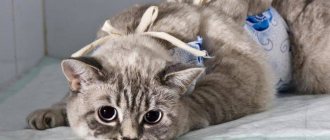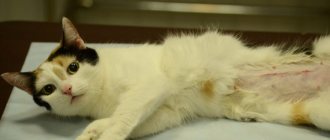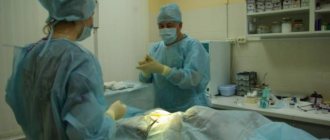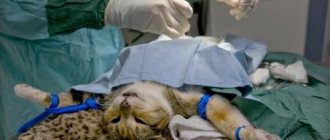Can a cat ask for a cat after sterilization?
In quite rare cases, a sterilized female may go on a spree after sterilization. Usually this process frightens the owners and makes them wonder whether the operation was successful.
Similar cases are possible when the pet experiences hormonal imbalances, and then the cat begins to:
- stick out your butt;
- trample;
- shout loudly.
The presence of such symptoms clearly indicates that the cat is asking for a cat. In this case, it is necessary to consult a veterinarian so that he can accurately identify the cause of this behavior.
What should the owner do?
If symptoms characteristic of a period of estrus appear, you should immediately take your cat to a veterinarian. To accurately establish the cause of behavior atypical for a castrated animal, an ultrasound examination is performed to identify the part of the ovary remaining in the body. An additional blood test is also done to study hormonal levels. However, diagnostics cannot always reveal the root cause why a sterilized cat is drawn to go for walks.
In case of hormonal imbalance, the animal is recommended to take injectable forms of appropriate medications.
If the ultrasound shows the presence of an ovary or part of it, then a broadband operation is performed. Minimally invasive intervention is ineffective in this case. In case of hormonal disorders, medications are prescribed that will suppress the animal’s sexual desire. Medicinal substances are injected with a syringe into the scruff or muscle exclusively by a veterinarian after an examination.
When estrus is caused by thyroid disease, the cat is examined for the presence of malignant neoplasms. Hormones that cause sexual desire are suppressed by implanting capsules under the skin. A neutered cat returns to a normal lifestyle after one session; repeated treatment is rarely required. It is strictly prohibited to self-medicate or make injections yourself if the endocrine glands malfunction.
Poor operation
A careless choice of the clinic and the doctor who performed the sterilization could lead to the fact that an inexperienced veterinarian did not remove all the ovaries. Even if part of the organ remains not removed, the production of hormones continues, and the cat may begin to ask for a cat.
Important!
To find out whether the doctor is at fault, you need to take the cat for tests and an ultrasound - these two types of diagnostics will accurately reveal the presence of remnant ovaries, which will confirm/refute the guess about a poor-quality operation.
To save the cat from the consequences of poor-quality sterilization, another operation will be required. This time you need to take your choice of doctor seriously.
Operation during estrus
Sterilization of cats during heat is carried out only for medical reasons. That is, when delaying surgical intervention can negatively affect the life and health of the furry patient. What is meant:
- Gynecological pathologies, including the appearance of tumors. In veterinary practice, there are known cases of pyometra formation even in very young animals. Signs of this disease are purulent discharge from the external genitalia. In this case, delaying the decision to intervene can lead to the development of sepsis (blood poisoning) and death.
- High excitability of the animal during the “rut”. The pet may show strong aggression and inadequacy. Although in such cases, veterinarians usually recommend the use of sedatives - they will stop nervous abnormalities before the end of the period of sexual hunting.
- A short break between heats indicates a malfunction of the hormonal system.
Arguments against performing the procedure
Refusal to perform surgery on an animal during the estrus (estrus) phase is due to the fact that the animal’s body is slightly weakened at this time. Failure to follow this recommendation can lead to difficulties:
- Risk of blood loss - at this time, the blood filling of the vessels increases by 1/3, so the slightest inaccuracy can lead to severe bleeding, which cannot always be stopped. And this poses a threat to the pet’s life.
- During estrus, the animal experiences a hormonal imbalance, as hormone levels reach their highest levels. Because of this, the recovery period for your pet may be delayed. In addition, signs of sexual desire (“phantom heat”) may persist for a short time, or a state of false pregnancy may occur.
- During this period, the animal’s uterus is enlarged, which complicates the process of performing the operation.
- If the animal has recently been ill or has a weakened immune system or is underweight, the load on the heart during the intervention will increase. And this can lead to negative consequences.
If the need for surgery is justified, then it would be better to do it using the laparoscopic method - the trauma associated with it is minimal.
Possible risks
The consequences of spaying a cat during heat are few. However, one cannot ignore the possibility of their occurrence. We are talking about complications:
- The appearance of internal bleeding.
- Inflammation of external or internal seams.
- Peritonitis.
But this is rare, since such complications are the result of failure to maintain sterility during the operation. But this is simply impossible for a good veterinarian. What else could it be:
- Minor pain in the first 24 hours after surgery.
- Reflex constipation in the first days.
Any veterinarian can cope with this. That is, treatment will need to be symptomatic.
Another possibility that the intervention will have consequences is associated with individual sensitivity (and the characteristics of the animal’s body) to anesthetic drugs. To avoid this, it is recommended that the cat undergo some tests before the operation: blood, ultrasound of the abdominal cavity, heart, ECG - this will help the doctor to select the anesthesia that will be as safe as possible for the pet.
Hormones
In an animal’s body, hormones can be produced not only in the ovaries: sometimes the cause of estrus is hormones produced by the adrenal glands, sometimes by the pituitary gland.
In rare cases, production may occur in a hormone-producing tumor.
The manifestation of such developments in a cat depends on its age at the time of spay removal. In young cats, the production of hormones by other organs occurs several times less frequently than in older females.
To make sure that the cause of estrus is not a tumor, it is better to take the cat to the clinic for an examination and undergo all hormone tests.
Heredity
A similar pathology forms in an animal even when it is in the womb.
Scientists call it ectopic ovarian tissue syndrome.
The problem is that during the formation of the ovaries, some tissue cells end up in another part of the animal’s body, and it is simply impossible to identify them in the formed and strengthened cat’s body.
Reference!
Such a hereditary predisposition is very rare.
What to do if the cat continues to walk?
First of all, the owner who notices signs of estrus in his cat should analyze the following points:
- how much time has passed since the operation;
- Could this be a reaction to the smell of valerian, catnip, etc.
Next, you need to contact a veterinary clinic, and it is advisable to choose a different one from where the operation was performed. It is necessary to take tests for hormones to determine whether they continue to be produced by the remnants of ovarian cells or other organs, and also do an ultrasound, which will indicate the presence of ovaries.
You will definitely need to make sure that the cause of hormone production is not a tumor; for this you will also need to undergo a series of examinations.
Solving the problem on your own with various pills that suppress estrus is not recommended. Often such drugs cause tumors and health problems.
What to do?
If your animal continues to exhibit this behavior, you should consult a doctor. Only a veterinarian, after examining the animal, will be able to make a preliminary diagnosis, and relying on test results to confirm it. After the disease has been diagnosed, it is possible to prescribe the optimal treatment process, which will be suitable on an individual basis. The use of sedative hormones is contraindicated. This may contribute to the formation of cancerous tumors. Often, your veterinarian will suggest using safe herbal sedatives.
It is also important after surgery to gradually reduce the amount of food or switch to a less caloric one. This is done for the following reasons:
- After removal of the reproductive organs, the animal is prone to weight gain.
- Excess energy interferes with calm.
If overexcited, the veterinarian suggests placing the cat separately. A minimal amount of stress will speed up the onset of peace and help avoid drug therapy. Often, in the postoperative period, the female recovers quickly. On day 2 the animal is already active. If the cat starts screaming after the intervention, the veterinarian prescribes Depogeston or Covinavet, Gestrenol or Libidomin.
Persistence of other behavioral traits that should have gone away
Each owner, when sending a cat for sterilization, pursues a specific goal. Such a goal could be:
- cessation of estrus;
- the cat stops yelling all day long;
- The cat stops marking its territory.
In some cases, this behavior may continue to manifest itself in pets.
For example, immediately after surgery, an animal may scream for a couple of months, since there are still “wandering” hormones in the body.
They can cause continued estrus for a short period of time after removal of the ovaries.
If the cat continues to scream, the type of surgery performed should be considered. For example, after the fallopian tubes are pulled, the female loses the opportunity to become pregnant, but the ovaries continue to produce hormones, and accordingly, the cat continues to scream. It is also worth making sure that the operation was successful.
Attention!
You just need to wait out the two-month period after sterilization - no need to give your cat pills that suppress estrus or panic. If the cat asks for a cat after 2 months after surgery, contact your veterinarian.
Types of operations
Sterilization can be of two types:
- Ovariohysterectomy – removal of the uterus and ovaries;
- Ovariectomy - removal of only the ovaries;
- Hysterectomy – removal of only the uterus;
- Tubal occlusion is the tightening or cutting of the fallopian tubes.
If the pet still has ovaries, she cannot become pregnant, but the production of sex hormones remains, which characterizes the possibility of continued estrus. Before sterilizing a cat, it is important to carefully familiarize yourself with the types of operations and all their consequences.
Should a cat stop marking?
The female stops marking after sterilization if she has not yet reached sexual maturity at the time of the operation.
Otherwise, such sexual behavior has already been established, and the lack of hormones may not affect it. In addition, this behavior completely depends on the character of the cat. She may not like such a small thing as the location of the tray, unknown and unpleasant odors, or simply the surrounding environment, but she can express her dissatisfaction in one of the few ways - by leaving marks.
The owner can deal with this problem in several ways.
- Ensure good ventilation in the house, eliminating unpleasant odors.
- Make sure the cat is not bothered by anything. In case of anxiety, you can rub flower infusions into the inside of the ear. They can also be added to the water that the animal drinks - no more than 1-2 drops.
- Special preparations sold in pet stores can eliminate the odors of existing marks. Their use is quite lengthy: most often, the areas marked by the cat must be treated every day for a month.
Reference!
Of course, all of the above should be put into effect only after the owner is convinced that sexual behavior has been consolidated and the operation has been performed correctly. If the production of hormones in the cat's body continues, the above methods may not help.
Why does a cat show interest in a cat after castration?
It is believed that after castration, a cat's interest in cats fades away within a few days and is never resumed. In the civilized world, it has long been customary to castrate cats that have no breeding value. However, sometimes it happens that after castration, a cat, to the great surprise of its owners, remains attracted to ladies of its own species.
The cat is clearly planning to do something with the kitty
There are many cases where cats that had been castrated for a long time again became gallant gentlemen when a fluffy person of the opposite sex appeared, or in the spring they behaved extremely depravedly with soft toys and the owner’s slippers.
The owners' reaction usually ranges from amazement to indignation at a poorly performed operation with claims against veterinarians.
However, whether such claims are justified is an ambiguous question.
Veterinarian's mistake
If the veterinarian kept silent about the fact that the cat, whom he supposedly castrated safely, is a cryptorchid and that the second testicle remained in the abdominal cavity, this is a veterinarian’s mistake.
It is impossible for a specialist not to notice this fact, and, most likely, he will have to perform abdominal surgery, at the expense of the institution (veterinary clinic).
Remember all
If the cat is an adult (over a year old) and has already had matings, then there is a possibility that he will never forget about this experience, and the corresponding aspects of behavior will be preserved.
After all, hormones are produced by the adrenal glands and the pituitary gland, and no veterinarian in his right mind would remove these organs from an animal to stop fertility.
However, it is impossible to predict such a development of events; not all cats are so temperamental, and most of them, after removal of the testes, forever lose interest in amorous affairs. And, if castration was carried out according to all the rules, then claims can only be addressed to nature itself.
Because, as already mentioned, it is impossible to stop the production of hormones by the pituitary gland and adrenal glands.
Chemical castration of a cat
If the owners chose chemical castration or vasectomy instead of a banal surgical solution to the problem, well, the risk is a noble cause, but they won’t have to drink champagne this time, since all other castration options, except the classic one, give half-hearted and unstable results.
In this case, they will only have to blame for their short-sightedness and misplaced pity. The solution may be to carry out full castration, but there may not be a 100% result.
Attenuation of sexual functions in a castrated cat
It is important to know that the attenuation of sexual functions in each cat occurs gradually and individually. This process can last for several months or even years, or it can end once and for all when the animal recovers from anesthesia.
A castrated cat climbs on a cat - consequences
A castrated cat can not only care for a cat, but also mount her, but sexual intercourse will occur without conceiving offspring.
He can't stop wanting a cat, but he can't become a father. However, there are isolated cases where a castrated cat managed to breed a cat in the first month after surgery, and kittens were born.
Perverted cats
An interesting fact: if there are two cats in the house, and both are neutered, then a “he-she” relationship is possible between them in cases where castration has no effect. Of course, there is nothing dangerous in such games, and there is no point in strictly suppressing them.
False pregnancy
After sterilization, a cat can be deceived by its own hormones. False pregnancy is a common occurrence in cats, and hormonal imbalances can trigger it. In addition, if mating has been made with a male, the female may also subsequently decide that she is pregnant.
A cat owner can identify the problem by a number of characteristic signs:
- the pet begins to look for a “nest” for itself: rummaging in closets and other secluded corners;
- change in behavior: females often become overly affectionate, or, conversely, do not want to make contact with people;
- the cat begins to carry various small objects (“kittens”) in its teeth.
You may also notice increased discharge from the vulva, enlargement of the abdomen and nipples, milk production, changes in appetite and other symptoms.
The manifestation of a false pregnancy after sterilization should be discussed with a veterinarian. This is very important, because sometimes such a failure can lead to the development of such unpleasant diseases as mastitis, pyometra, and in rare cases, tumors and endometritis.
Other tips
If after sterilization the cat begins to demand a cat, it is necessary to reduce the calorie content of its diet.
Eating nutritious food helps increase sexual performance. In addition, the operated pet is in great danger of gaining excess weight. To prevent the development of obesity, you should reduce portions of foods. The answer to the question of whether a cat can ask for a cat after sterilization is certainly positive. Sometimes owners have to give the animal drugs to stop sexual activity. However, in some cases, avoiding stress can help eliminate the symptoms of sexual desire without medication. It is better to place the female in a separate room. This will allow the animal to calm down.











